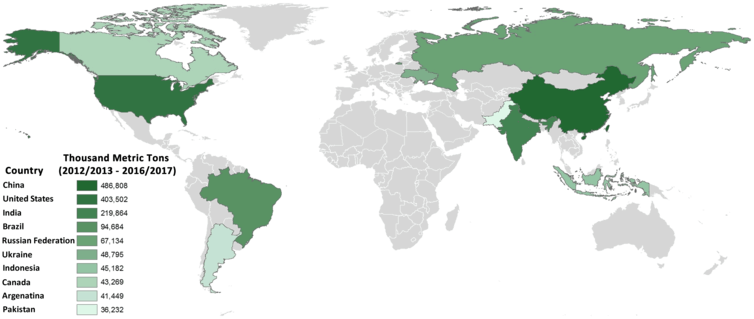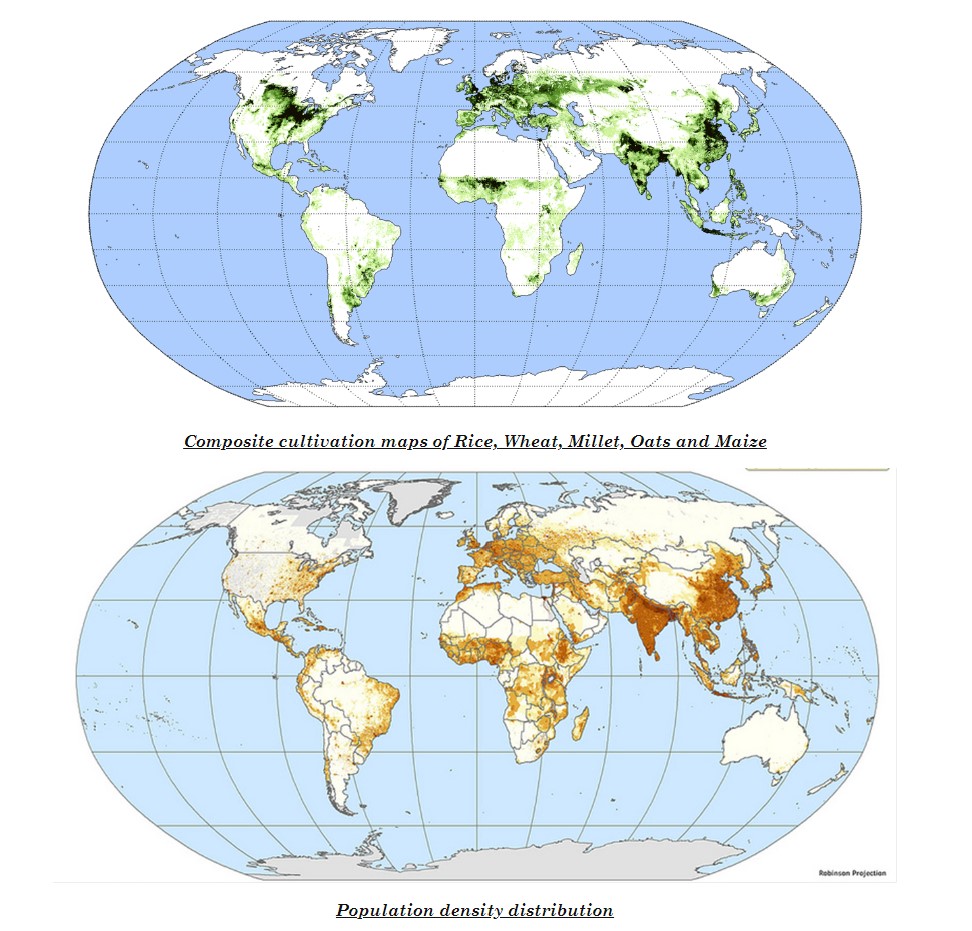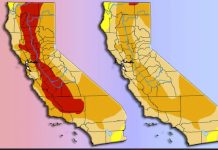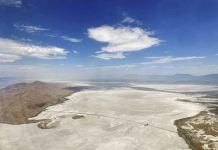
Well right now over 50% of the US is in some form of drought – the US happens to be a breadbasket region. The North Central US/Canada is not in a drought (but it was severe last year), and that area alone is responsible for a lot of our canola and wheat production.
But the Russian roulette of Drought stricken areas has hit all the below at the same time in many cases, in (record breaking in some) droughts:
- Northern Africa, and Southern Africa is in drought right now.
- Central South America is (fairly fucked) in drought right now.
- Europe is (Definitely fucked) in drought right now.
- US West (certainly fucked), and New England (more and more consistent) are in a drought right now.
- Bangladesh and Western India are in drought right now.
- While northern China is being battered by floods, southern China is facing an extreme heat wave depleting rivers and reservoirs…
Note that of the above – many of these regions have re-occurring droughts, with one year no drought, followed by another year in drought.
Just because the US central area is OK in 2022, remember in 2021 it had record drought. That’s really odd shit. Historically these came maybe once every decade. Now they come once every couple of years.
There’s 8 billion of us, but only if there’s enough rain to grow the grains to feed our livestock and grow our wheat, rice, and corn. This is just the beginning of global droughts that occur at the same time. That’s the key.

Our global society can be quite resilient to one or two droughts, but not if it hits multiple bread basket regions at the same time on different continents.
Just keep in mind that rapid social collapse can create cascading effects that completely and rapidly collapse the system. Once the rope gets too unraveled, it’s impossible to twist back together, and society permanently collapses.
If too many bread basket regions do not get rain, there’s no ability to innovate our way out of that situation. When that happens, social unrest can be rapid – and if enough of the fossil fuel supply chains get disrupted…even for a 2-3 of weeks, that’s game over.
Extreme heat is slamming the world’s three biggest economies all at once
Extreme heat and drought conditions are battering the United States, Europe and China, compounding problems for workers and businesses at a time when economic growth is already slowing sharply and adding to upward pressure on prices.
In China’s Sichuan province, all factories have been ordered shut for six days to conserve power. Ships carrying coal and chemicals are struggling to make their usual trips along Germany’s Rhine river. And people living on America’s West Coast have been asked to use less electricity as temperatures soar.
These events “have the capacity to be quite significant for the particular regions that are affected,” said Ben May, director of global macro research at Oxford Economics.
The extent of the pain could depend on how long the heatwaves and lack of rain last. But in countries like Germany, experts warn there’s little relief in sight, and companies are preparing for the worst.
Extreme weather and an economic slowdown
It’s not just the Rhine. Around the world, rivers that support global growth — the Yangtze, the Danube and the Colorado — are drying up, impeding the movement of goods, messing with irrigation systems and making it harder for power plants and factories to stay cool.
At the same time, scorching heat is hampering transportation networks, straining power supply and hurting worker productivity.
“We shouldn’t be surprised by the heat wave events,” said Bob Ward, policy and communications director at the London School of Economics’ Grantham Research Institute on Climate Change and the Environment. “They’re exactly what we predicted and are part of a trend: more frequent, more intense, all over the world.”
China is facing its fiercest heat wave in six decades, with temperatures crossing 40 degrees Celsius (104 degrees Fahrenheit) in dozens of cities. Parts of California could see temperatures as high as 109 degrees Fahrenheit this week. Earlier this summer, temperatures topped 40 degrees Celsius in the United Kingdom for the first time ever.
The global economy was already under pressure. Europe is at high risk of a recession as energy prices soar, stoked by Russia’s invasion of Ukraine. High inflation and aggressive interest rate hikes by the Federal Reserve jeopardize growth in the United States. China is grappling with the consequences of harsh coronavirus lockdowns and a real estate crisis.
“At present, we are at the most difficult point of economic stabilization,” Chinese Premier Li Keqiang said this week.
Something else to worry about
Extreme weather could exacerbate “existing pinch points” along supply chains, a major reason inflation has been difficult to bring down, May of Oxford Economics said.
China’s Sichuan province, where factories have shuttered production this week, is a hub for makers of semiconductors and solar panels. The power rationing will hit factories belonging to some of the world’s biggest electronics companies, including Apple (AAPL) supplier Foxconn and Intel (INTC).
The province is also the epicenter of China’s lithium mining industry. The shutdown may push up the cost of the raw material, which is a key component in electric car batteries.
The neighboring city of Chongqing, which sits at the confluence of the Yangtze and Jialing rivers, has also ordered factories to suspend operations for a week through next Wednesday to conserve electricity, state media The Paper reported.
Forecasts for China’s economy this year are already being downgraded as a consequence. Analysts at Nomura cut their 2022 projection for GDP growth to 2.8% on Thursday — way below the government’s 5.5% target — while Goldman Sachs trimmed its forecast to 3%.
Germany’s shrinking Rhine, meanwhile, has dropped below a critical level, impeding the flow of vessels. The river is a crucial conduit for chemicals and grain as well as commodities — including coal, which is in higher demand as the country races to fill storage facilities with natural gas ahead of the winter. Finding alternative forms of transit is difficult given labor shortages.
“It is only a matter of time before plants in the chemical or steel industry are shut down, mineral oils and building materials fail to reach their destination, or large-volume and heavy transports can no longer be carried out,” Holger Lösch, deputy director of the Federation of German Industries, said in a statement this week.
Low water levels along the Rhine shaved about 0.3 percentage points off Germany’s economic output in 2018, according to Carsten Brzeski, global head of macro at ING. But in that instance, low water wasn’t a problem until late September. This time around, it could lower GDP by at least 0.5 percentage points in the second half of this year, he estimated.
Economic sentiment in Germany continued to dip in August, according to data released this week. Brzeski said the country “would need an economic miracle” to avoid falling into a recession in the coming months.
In the American West, an extraordinary drought is draining the nation’s largest reservoirs, forcing the federal government to implement new mandatory water cuts. It’s also forcing farmers to destroy crops.
Nearly three quarters of US farmers say this year’s drought is hurting their harvest — with significant crop and income loss, according to a survey by the American Farm Bureau Federation, an insurance company and lobbying group that represents agricultural interests.
The survey was conducted across 15 states from June 8 to July 20 in extreme drought regions from Texas to North Dakota to California, which makes up nearly half of the country’s agricultural production value. In California — a state with high fruit and nut tree crops — 50% of farmers said they had to remove trees and multiyear crops due to drought, which will affect future revenue.
Without significant investment in upgrading infrastructure, costs will only keep rising, Ward of the London School of Economics noted. And the impact may not be incremental.
“There are signs these heat episodes are not just becoming slightly more intense and frequent over time. It’s happening in a kind of non-gradual way, and that will make it more difficult to adapt,” Ward said. [CNN]
StrangeSounds.org has been banned from ad networks and is now entirely reader-supported CLICK HERE (or the banner below) TO SUPPORT MY WORK… I will send you a small gemstone if you give more than 25$… Thanks in advance!
Another way to support my work is by signing in to get FREE information about how to invest in GOLD, SILVER and other PRECIOUS METALS to limit the effects of inflation on your IRA/4001K… As the Dow Jones is sinking and the inflation is hiking it’s the right time to invest in precious metals!
You will finally find some great affiliate products that I recommend you to add to your disaster & preparedness kit:
- Qfiles is another great site for alternative news and information…




















The Movie Right at your door , and collpase must be seen …. With three different endings …
https://www.youtube.com/watch?v=0S9uvhjTiBA
World events will happen siddenly changes all mankinds destinations for ever. If you do not have food , water medicines for 6-1 year Then read John Hague … https://www.jonhague.com/
The Krill, which is like the Pope of the Russian Orthodox Church, said a couple of years ago that we are in the end times and if you can’t see that you are not looking.
Go in a diet. I won’t hurt your health to fast a little.
This is end time. Get saved in Jesus only!!!
what a challenge!!! This is discouraging
The end of this age is at here already. Anyone that is not saved today should get ready for whatsoever he/she sees tomorrow. Get you saved in Jesus only!!!
I just keep buying, stockpiling, and smiling. We just had multiple flood articles offset by drought articles. We have had recent snowing articles too. Are the satanic elitists draining the water off into their doomsday underground bunkers? Thr future does not look promising. We have plagues (diseases), famines, and moral collapse and satanists coming out of the woodwork.
I have worked outside most of my life. We have had cooler temps the last few seasons. Our rain in our area has been steady and sometimes severe. This drought seems like a man-made psyop. It’s like they are creating the effects of global warming to compliment their global warming psyop.
I’m not sure if this article degraded into Lordal Globing propaganda towards the end since I only read the first half.
It’s pretty darn simple – atmospheric water vapor has decreased quite dramatically worldwide. It’s what happens when you enter a grand solar minimum, less evaporation less humidity. It doesn’t help that most of the sierra trees are gone now from bark beetle infestation – I kid you not – the sierras south of tahoe are basically a desert of nothing but dead trees – south america has devastated its rainforests as well.
Condensation creates heat and evaporation cools – a nice feedback loop making earth liveable. Solar cycles and water vapor control long term climate….PERIOD. This is well known to the “elite” but they don’t want mass migration to equatorial regions – you’ll have to get a clue when the growing season is halved (already happening) – and permanent glaciers enter states like michigan – by 2030 certainly.
It’s simple people, low water vapor = extreme heat and cold.
Lordal globing is a wall street scam (it must be real swell to invest and then write the laws) – and another big step toward global marxism.
PS – I’m not gonna tell you how I know the atmospheric water vapor is decreasing rapidly – who knows what these evil overlords are capable of.
floods in all grey areas or more than average rainfall… they have f***ed up.
Yep. Little time to prepare. I believe many of the recent food recalls are the Elite stocking up. They know this is not Geoengineering. But the beginning of massive change.